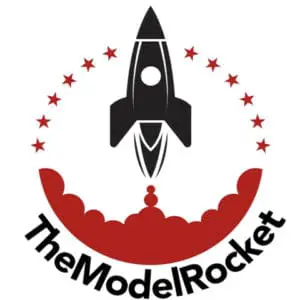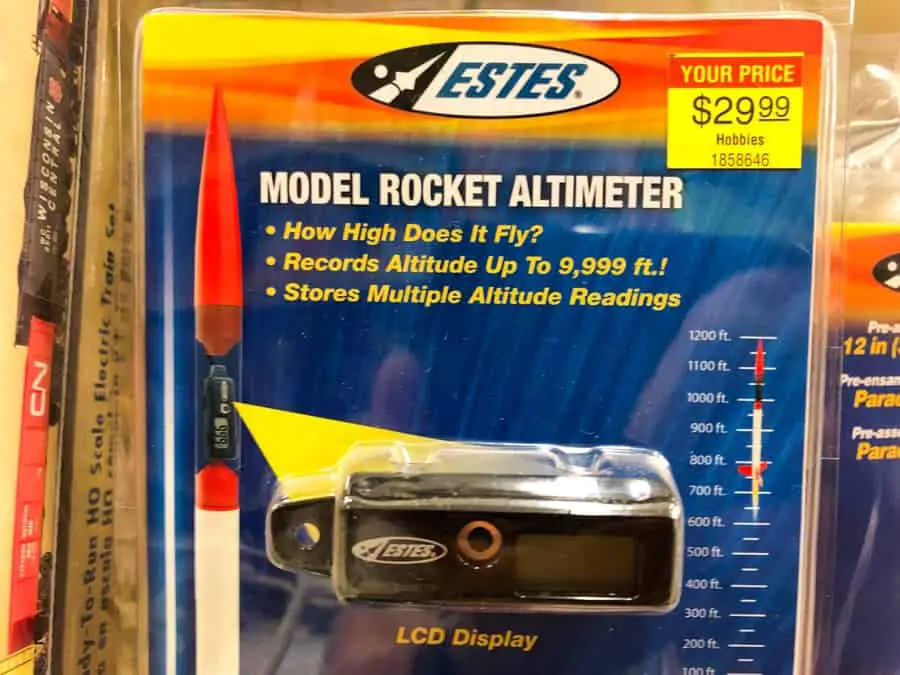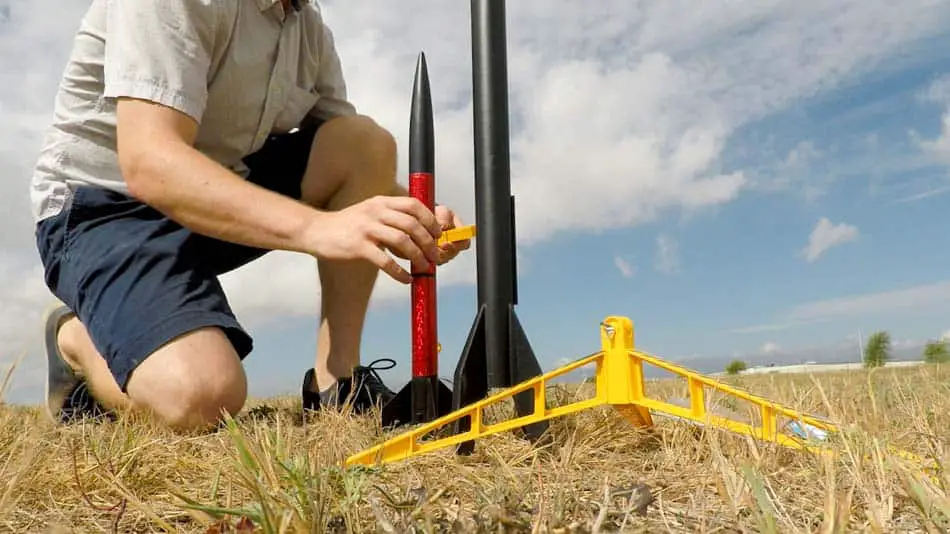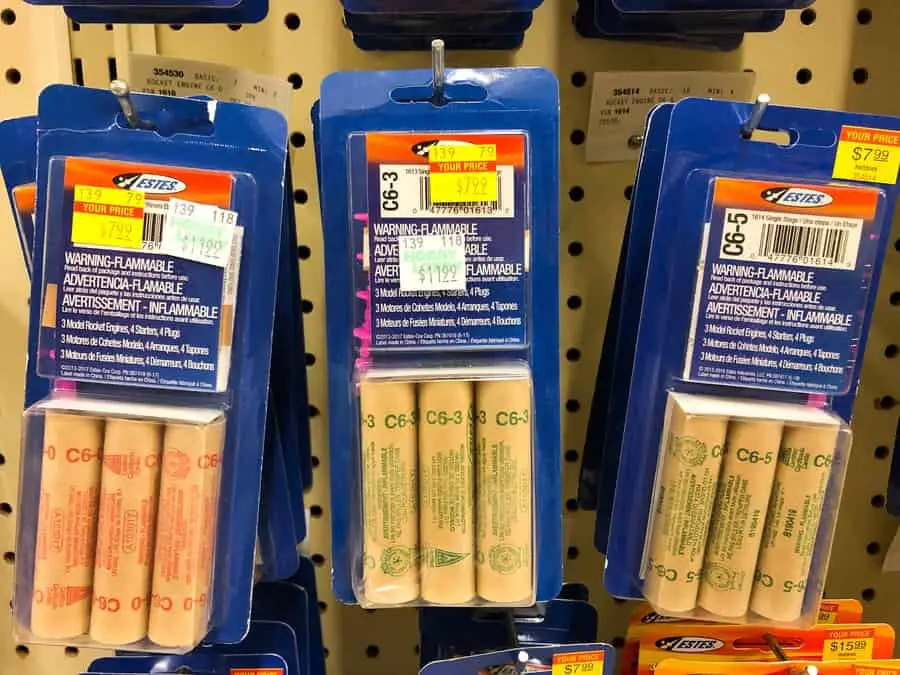
When I first entered into the world of flying model rockets, I tried my hardest to research all of the different classifications and motors available. If you are not a complete aeronautics genius, and maybe you just wanted to get into a new hobby, the information available is mind-boggling. Equations and nomenclature that you might not have ever heard of before are thrown at you from all directions.
It’s important to have a deep understanding of how rocket motors are classified and what the various different types are so that you can successfully launch your rocket, know what to expect, and even compete in competitions with other rocket aficionados. But first, at a high level, what are the model rocket engine sizes and classifications?
Model rocket engines are classified by engine sizes A through O, with the higher letters being more powerful. The numbers associated with each engine letter describe the burn duration and delay before firing an ejection charge. Certain engine sizes require further certifications and licenses in order to use.
Here’s a simplistic chart of the varying model rocket engine classifications:
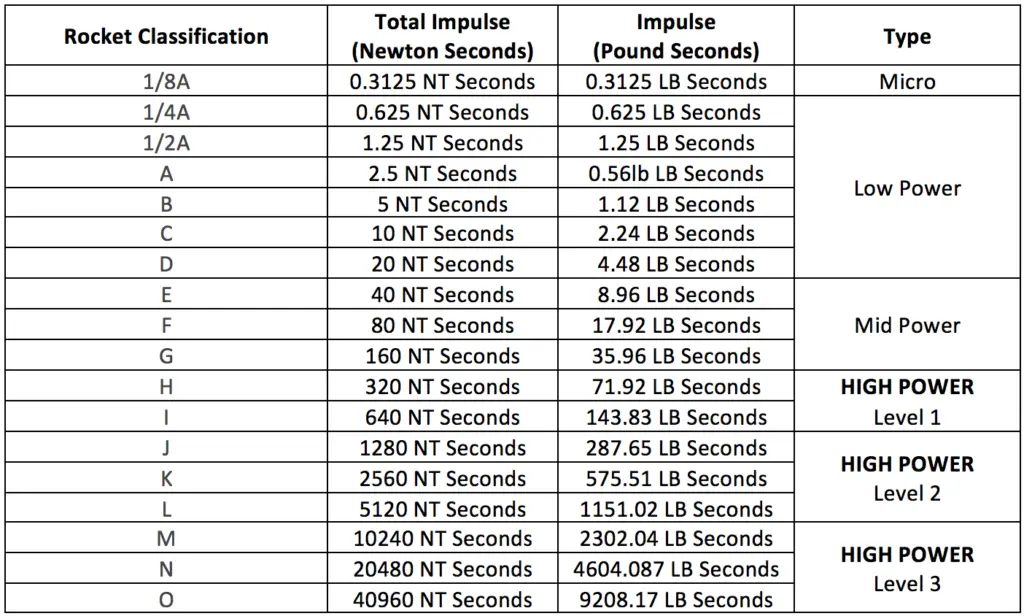
You might have seen a similar chart like this before when researching model rockets, but what do all these numbers and letters really mean? In this article, I’ll walk you step-by-step on understanding the engine sizes, classifications, and nomenclature used.
Are you still using the standard Estes controllers for your launches? Have you considered building your own custom launch controller? We just built our own beautiful launch controllers that make launches SO much more fun, and we documented EVERY single step and item purchased and put it into a step-by-step course that teaches you how to do the exact same thing.
Click here to learn more about how you can build your own launch controllers!
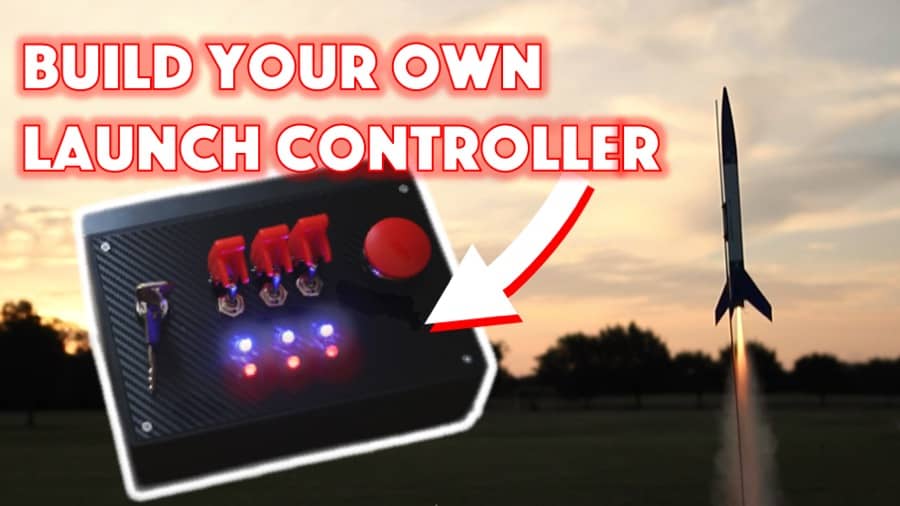
What is a Total Impulse?
It does no good to review the total impulse of a rocket motor without first understanding what that number reflects, as well as it’s importance. Total impulse is obtained by taking the average thrust of the rocket and multiplying it by the total burn time of the motor. It can be measured in either newton seconds or pounds seconds.
Burn time is the total allotted time that the motor produces thrust altogether. It’s the time measured that shows how long the motor actually propels the rocket.
Average thrust is measured by dividing the complete thrust over the complete burn time of the motor. Thrust is the force the motor produces during its complete burn time. Finding the average thrust will help you determine how much weight a specific motor can handle.
Using burn time and average thrust in your calculation for total impulse will help you figure out the complete amount of momentum the motor can provide to the model rocket.
Thrustcurve.org offers a great visual chart of these calculations here.
Or, check out NASA’s official graph here for calculating model rocket engine designation.
How to Decipher the Motor Codes, What Do the Numbers and Letters Mean?
While figuring out the specific class of the motor is simple, and we’ve already gone over it’s relation to total impulse, you may have noticed that all model rocket engines being sold have designated numbers following the letter. What do these numbers mean?
For example, let’s look at the model rocket engine number A8-3. This is a commonly used single stage motor. What exactly does the, “8-3” mean?
The complete motor code is built from the following specifications:
Total Impulse (Letter) + Average Thrust in Newtons (First Number) + Time Delay in Seconds (Second Number)
An A8-3 motor, has a total impulse of 2.5 Newton Seconds, with an average thrust of 8 Newtons, and a Time Delay of 3 seconds.
Some A motors have a “1/2”, “1/4” or, “1/8” in front of the letter itself. This simply means that motor is exactly one half, one fourth, or one eighth the size of an actual A motor.
We’ve already discussed what total impulse and average thrust are, along with how they are calculated, but now you might be wondering:
What Is A Time Delay?
Rocket engines are constructed with a delayed charge mechanism that helps prevent the recovery system from deploying too early. Each rocket engine will on average burn up its propellant in a designated time frame. This is usually about 1 second. However, even after the propellant is gone the rocket continues in an upward path, and you would not want the recovery system to activate.
Activating the recovery system this early would likely result in a failed recovery and the parachute would be rendered useless, thus leaving your model rocket to crash and become damaged. You’ll notice when the time delay charge has begun that it sends out smoke from within the rocket that you can visually track. This also helps you to see where the rocket is. Once the smoke is gone, the recovery is activated.
Altimeter
Larger and higher-powered rockets may be equipped with an altimeter. This device determines that altitude the rocket has attained and makes the determination based on this figure of when to activate the recovery system successfully. We put together a whole starter guide for Model Rocket Altimeters and Accelerometers if you’d like to know more about this topic and see some affordable options to adding these to your rocket.
Here’s a chart I’ve put together so you can have a quick visual of the common motors and their codes.
| Motor Type | Average Thrust (Newtons) | Time Delay (Seconds) |
| 1/4A3-3 | 3 | 3 |
| 1/2A3-2 | 3 | 2 |
| A3-4 | 3 | 4 |
| A10-3 | 10 | 3 |
| 1/2A6-2 | 6 | 2 |
| A8-3 | 8 | 3 |
| B4-2 | 4 | 2 |
| B4-4 | 4 | 4 |
| B6-2 | 6 | 2 |
| B6-4 | 6 | 4 |
| C6-3 | 6 | 3 |
| C6-5 | 6 | 5 |
| C11-3 | 11 | 3 |
| C11-5 | 11 | 5 |
| D12-3 | 12 | 3 |
| D12-5 | 12 | 5 |
| E9-4 | 9 | 4 |
| E9-6 | 9 | 6 |
| 1/2A3-4 | 3 | 4 |
| A8-5 | 8 | 5 |
| B6-6 | 6 | 6 |
| C6-7 | 6 | 7 |
| C11-7 | 11 | 7 |
| D12-7 | 12 | 7 |
| E9-8 | 9 | 8 |
Black Powder Rocket Motors VS Composite Motors
There are two types of rocket motors that can be used black powder rocket motors and composite motors. Black powder rocket motors are the most commonly seen engines.
How Does A Black Powder Rocket Motor Work?
It may seem obvious by the name, but these little motors are stuffed with black powder propellant. They have an iconic brown paper-like shell in the form of a tube. Along with the propellant is the delay charge with smoke and the ejection charge. In front of the propellant is a clay-like material known as the nozzle.
When it comes time to launch the model rocket, an igniter will be inserted into the nozzle, and the launch device will use this igniter to effectively explode the propellant, resulting in a launch.
How Does A Composite Motor Work?
A composite motor works nearly the same as a black powder rocket motor except instead of utilizing black powder these engines are built with a composite propellant that is nearly three times as powerful as black powder motors the same size. This extra power is extremely beneficial as composite motors can be made much smaller and lighter but drive the same amount of power.
Composite motors are both sold as single-use and reloadable. The reloadable type features an aluminum casing that can be used multiple times and cleaned, helping the model rocket user save money and have the ability to build their own engine. Reloadable engines are seen more with high-powered model rockets.
What are the Different Sizes and is Bigger Better?
Larger engines can, in fact, produce greater average thrust volumes, and drag force which directly corresponds with how much weight the engine can pull and the maximum thrust that might be achieved. You’ll commonly find that large model rockets use large engines because they can pull more weight. That doesn’t mean they will fly higher than a smaller rocket that is using a smaller engine, though.
All things such as weight, drag force, average thrust, and maximum thrust should all be considered. A smaller engine could have a very similar maximum thrust and achieve the same height, but it may not be able to pull as much weight as a larger engine.
Here is a chart of standard sizes based on the motor class.
Note: These sizes are standard only, and many manufacturers may have different diameter and length specifications than what is listed on this chart.
| Motor Type | Average Diameter (mm) | Average Length (inches) |
| 1/4A | 10.5 | 1.5 |
| 1/2A | 10.5 | 1.5 |
| A | 13 | 1.75 |
| B | 18 | 2.75 |
| C | 18 | 2.75 |
| D | 24 | 2.75 |
| E | 29 | 4.88 |
| F | 29 | 4.88 |
| G | 29 | 4.88 |
What are Multi-Stage Engines?
Some model rocket designs utilize two or possibly three motors in stages. There are single-use motors, and then there are multi-stage motors. Multi-stage motors will have a lower and sometimes intermediate stage motor that will show a value of 0 instead of a delayed time. This is because they do not have a delayed time mechanism; they only contain propellant.
The final stage or, “upper stage” engine will include the delay and ejection system. The lower and intermediate stages burn through the propellant that applies heat through the nozzle of the next stage successfully igniting it in succession.
Only black powder engines can be used in multi-stage rockets. Composite engines are designed with a propellant that requires high pressure to sustain burning. This need makes it difficult for the heat and flame to pass from motor container to the next motor container. Thus, they normally just burn out.
The main benefit of having a multi-stage motor is that it will fly much higher. This also means though that it will drift further in the wind, so special consideration has to be taken when choosing the appropriately sized launch field.
Can You Build Your Own Model Rocket Engine?
You may run into some conflicts building your own model rocket engine if you have to ask permission for use of land to launch, or you have to discuss approval with your local fire marshal. If you don’t look like a professional who knows what you’re doing, it might rub a few local agencies in control of your park grounds the wrong way.
The main reason it can be an issue with obtaining approval from fire marshals and local agencies is that you can’t necessarily tell them how high or how far the model rocket may ultimately go. This makes it hard to figure out if you have the appropriately sized launch field to keep you and others in proximity safe.
In fact, in the state of California, you legally can not use an engine that is not certified by the NAR (National Association of Rocketry) first. California is officially the only state that has such a strict rule on model rocket engines and what is allowable. Not only do they have to be certified by the NAR, but they must also be certified by the state itself before use.
You’ll probably run into some conflicts if you plan to use the motor in a NAR competition or launch area as well, their safety codes restrict the use of any engine on a specified field that is not certified by their association. They also have a designated Range Safety Officer on every site that makes sure all model rockets being used are first certified and do not conflict with their safety rules.
If you plan to make your own rocket fuel, exercise extreme caution. The materials you are working with can be explosive and extremely dangerous. This website does not advise you to make your own rocket fuel.
If you’re curious, here is a good overview of someone else making rocket fuel. Again, exercise extreme caution if you plan to do this as it can be very dangerous.
Some commonly expressed tips were:
- If using a pre-manufactured model rocket, you’ll have to build your engine to fit the stock engine mount your rocket comes with, or you’ll need to modify the engine mount to make it work.
- Be prepared for failure, and maybe opt to use an inexpensive rocket or two for testing.
Model Rocket Engines That Require Certification
There are some model rocket engines that require certification, licensing, or permits in order to operate/use because they are considered high-powered. Here is a list of these certification levels and the corresponding rocket engine classifications they are assigned to.
Level 1 Certification
Level 1 certifications allow the purchase of motors that are in the H, and I total impulse category. These classifications have motors that boast total impulses of 320-640 Newton Seconds. On average the cost of these motors might run you anywhere from $40-$65.
Level 2 Certification
Level 2 certifications allow the purchase of motors that are in the J, K, and L total impulse category. These classifications have motors that have total impulses of 1,280-2,560 Newton Seconds. You cannot apply for a level 2 certification without at least obtaining a level 1 first. On average the cost of these motors might run you anywhere from $70-$230.
Level 3 Certification
Level 3 certifications allow the purchase of motors that are in the M, N, and O total impulse category. These classifications have motors that show total impulses of 10,240-40,960 Newton Seconds. This certification also requires that the model’s design and construction be thoroughly reviewed prior to flight. These motors will run anywhere between $300 to $1,000+.
FAA/AST Permit/License Required
P motors that have a total impulse of up to 81,920-newton seconds require an FAA/AST permit or license to purchase and operate. These rockets are considered “suborbital rockets.” Find out more information on the experimental permits required here.
Largest Rocket Motor Used by Amateurs
Classified as the S motor with a total impulse of 655,360 Newton Seconds, this motor is the largest kind to be used by amateur rocket builders. The team behind the rocket that used the motor was known as CSXT they were the first entity to actually launch an amateur rocket in space. They did this on May 17th of 2004. We wrote an article covering the CSXT and if model rockets can reach space. Check it out!
How High Can My Model Rocket Go Based on The Motor?
So, we’ve explained the different model rocket motor classifications, sizes, types and what total impulse means, but in simple terms, maybe you just want to know how high the rocket can really go based on engine size.
How high the model rocket goes will depend on a few things:
- The maximum thrust of the engine
- The maximum lift weight of the engine
- The weather conditions during the launch
- The design of the model rocket body
- Is the rocket using a multi-stage motor?
Model rocket engine manufacturers like Estes list out their maximum thrusts and lift weights on a helpful chart here. If you’re buying a complete assembly of a model rocket, it might give you a specific idea of how high the model rocket will travel. If you’re building your own, and simply purchasing a certified engine, you’re going to have a hard time determining beforehand how high it will really travel.
The most common model rocket engines can fly from 100 feet up to several thousand feet. I’ve put together a chart on the most common model rocket engine classifications and their average expected heights based on a few of the top manufacturers’ listed specifications. Again, be advised these are just average ranges and ultimately the model rocket body, weather, and more might change these figures.
| Rocket Classification | Average Height |
| 1/8A | 100 – 300 ft |
| 1/4A | 100 – 500 ft |
| 1/2A | 100 – 500 ft |
| A | 300 – 800 ft |
| B | 500 – 1200 ft |
| C | 500 – 1500 ft |
| D | 700 – 1800 ft |
| E | 1000 – 2300 ft |
| F | 1500 – 3000 ft |
| G | 1800 – 3200 ft |
How to Select the Right Motor
Selecting the right motor is not as simple as determining how high you want your model rocket to go. If you’ve already purchased a model rocket kit, most manufacturers will list the recommended engine for this rocket to have optimal performance and altitude.
If you’re building your own model rocket, it may take some trial and error in figuring out the right motor for use. These things have to be considered:
- The weight of your model rocket total and the maximum weight pull of the engine.
- The size of the engine compartment.
- The delay time your rocket will need for a successful recovery.
Apogee Rockets offers a great walkthrough guide on determining the best motor to use with your model rocket, read it here.
You might also explore available rocket software like RockSim, which Apogee recommends in their walkthrough guide. This software allows you to design your rocket with different motors installed and the software will let you know your expected statistics and suitability based on your choices and design. This software does cost about $125, but they offer a free 30-day trial or your money back.
Learn more about RockSim, or purchase it here.
Exploring Model Rocket Kits for Purchase
The easiest way as a beginner to set out into the world of launching and flying model rockets is to buy one already designed and ready for assembly and launch. Usually, the manufacturer will even give you a pretty accurate estimate of how high the model rocket can go based on the recommended engines.
Let’s walk through a few of the popular model rockets being sold on Amazon right now (Note these kits do not come with the rocket model engine, but all of the rockets featured use one or multiple of the engines discussed above in this article, you’ll find these listed in the specifications):
Beginner Kits
Estes Alpha III Rocket Launch Set (link to read reviews on Amazon)
This beginner’s rocket kit is recommended for anyone 10 years and older. It’s very simple to put together and doesn’t require any painting.
Included in the kit is:
- Launch Controller
- Launch Pad
- Rocket Assembly Kit
- Orange Plastic Nose Cone
- Body Tube
- One-piece plastic tail fin unit
- Decals for decoration
What’s not included:
- Model rocket engine
- Starters
- Recovery wadding
- Glue
Specifications:
- Skill level: E2X, simple to glue, no painting required
- Age Requirement: 10 years and up, adult supervision under 12
- Engines Recommended: 1/2A6-2, A8-3 (first flight), A8-5, B4-4, B6-4, B6-6, C6-5, C6-7
- Projected Max Altitude: 1,100 feet
- Weight of Rocket: 1.2oz
Purchase the Estes Alpha III directly on Amazon here.
Estes 2452 Athena Flying Model Rocket Kit (link to read reviews on Amazon)
As one of the most popular beginner’s rockets from Estes, the Athena comes completely fully assembled, so you don’t even have to worry about the effort in putting it together, you can get ready for immediate launch!
Included in the kit is:
- Fully Assembled Model Rocket
- Parachute Recovery System
Not included in the kit:
- LaunchPad
- Controller
- Model Rocket Engines
- Wadding
- Igniters
- Igniter Plugs
Specifications:
- Skill Level: Beginner, Already Assembled
- Age Requirement: 8 years and up
- Engines Recommended: A8-3 (first flight), B6-4, C6-5
- Projected Max Altitude: 1,125 feet
- Weight of Rocket: 1.4oz
Purchase the Estes Athena directly on Amazon here.
Advanced Kits
Estes 2440 Magician Flying Model Rocket Kit (link to read reviews on Amazon)
This incredibly tall model rocket (33.5 inches tall to be exact) is manufactured for use with D and E rated engine, and can soar nearly 1600 feet! The rocket is designed to have a larger than normal payload. The fins of the rocket are produced with laser cut wood fins, and the rocket comes with an 18-inch parachute that is already assembled.
Included in the kit is:
- Body tubes
- Laser-cut wood fins
- Waterslide decals
- Payload section
- 18-inch parachute
Not included in the kit:
- Building supplies
- Finishing supplies
- Model rocket engine
- Launchpad equipment
Specifications:
- Skill Level: Advanced, Assembly Required
- Age Requirement: 18 years or older, adult supervision under 18
- Engines Recommended: D12-5, E9-6
- Projected Max Altitude: 1,600 feet
- Weight of Rocket: 3.5oz
Purchase the Estes Magician directly on Amazon here.
Expert Kits
Estes Comanche-3 Shuttle Flying Model Rocket Kit (link to read reviews on Amazon)
For the expert model rocket enthusiast. The Comanche-3 features three stages, which mean it uses three engines to achieve its outstanding altitude! Assembly may take up to a day, but the wait is well worth the pleasing abilities of this model rocket!
Included in the kit is:
- High-quality body tubes
- Laser-cut balsa
- Cardstock parts
- Plastic nose cones
- Waterslide decals
- 24” preassembled parachutes
Not included in the kit:
- Launch controller and pad
- Tools, construction and finishes supplies
- Recovery wadding
- Model rocket engines
Specifications:
- Skill Level: Expert, assembly required
- Age Requirement: 10 years or older, adult supervision under 12
- Engines Recommended:
- 3 Stage Launches:
- 1st Stage: C11-0, D12-0;
- 2nd Stage: B6-0, C6-0;
- Rocket: B6-6, C6-7
- 2 Stage Launches (using 2nd and 3rd Stages)
- 2nd Stage: C6-0
- Rocket: B4-4, B6-4, C6-5
- Rocket Only: B4-4, B6-4, C6-5
- 3 Stage Launches:
- Projected Max Altitude: 2,250 feet
- Weight of Rocket: 2.5oz
Purchase the Estes Comanche directly on Amazon here.
Build Your Own Launch Controller
Don’t forget! We recently built our own beautiful launch controllers that made the launch process SO much more fun! And we documented everything about it and put it into a super easy to follow step-by-step course showing you how to do the exact same thing! It’s called License to Launch and available here! Here’s an overview:
